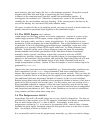merit function, plus any binary file, list, or slice bitmaps requested. Doing this on each
iteration takes little time and helps in supervising the run’s progress.
(vi)Based on the computed merit function, update the optimization simplex. If
convergence has occurred, exit. Otherwise, compute new values of the controlling
variables for the next iteration and keep iterating. If the current point is the best so far,
save all the bitmap, list, and mode files under another name.
Of course, in order for this to do anything useful, you have to specify a merit function (or
penalty function for pessimists) that depends on the simulation output.
2.3. The FDTD Engine: FIDO/TEMPEST
POEMS started out life using TEMPEST as its main component. TEMPEST is a more or less
vanilla single-processor FDTD engine, written originally for simulation of phase-shift
masks, but quite widely used for a variety of applications. It is described in its own
documents, which accompany the POEMS distribution. Due to the limitations of TEMPEST,
in particular its lack of subgridding and multiprocessor capabilities, POEMS now relies
principally on a specially written FDTD engine called FIDO, for FInite difference time
DOmain. In broad outline, each of these programs parses an input file containing
human-readable, hard-coded specifications of the simulation domain, boundaries,
materials, objects, sources, and binary output files; constructs and runs a FDTD
simulation as specified, stopping when the specified degree of convergence has been
attained or the maximum cycles exceeded, and producing large binary files full of E and
H values. TEMPEST comes with Matlab scripts to plot these simulated fields and do
simple manipulations on them. Section A.2 has an example of a FIDO/TEMPEST input file
generated by poems.cmd.
TEMPEST also has some more advanced capabilities, e.g. Fourier boundary conditions, far-
field computation (via the orders output command), and more complicated source
shapes, that POEMS ignores in favour of its own more general versions. This was done for
reasons of usability and to avoid being tied too tightly to one particular simulator engine.
One additional (and most important) attribute of TEMPEST is that it is well validated.
Besides having been tested on problems whose analytical solution is known, it has done a
good job for lots of people over several years. For this reason, FIDO was written to be a
plug-compatible superset of TEMPEST: it takes the same input files, and can do the same
simulations, but FIDO is about 50% faster on a per-processor basis and can do subgridded
and clusterized simulations as well. Thus in new situations we can test our simulations
using TEMPEST and then refine them using FIDO.
2.4. The Postprocessor: EMPOST
Large binary files full of E and H values are not very useful by themselves. The tool set
provided by POEMS requires a lot of CPU-intensive calculations and binary manipulations
that are much better done in C++ than in REXX. Accordingly, POEMS uses a
postprocessor written in C++ to do most of its numerical work. EMPOST takes a human-
readable but quite rigidly formatted orders file that specifies what is to be done on what
data. An example is shown in Section A.3.
It is occasionally useful to run the postprocessor manually, e.g. when we want to change
7


















